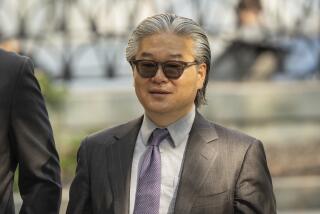Rip the Cover Off Hedge Funds
- Share via
For now the high-risk private investment fund of Long-Term Capital Management is intact, thanks to the Federal Reserve Bank of New York, which helped bring together 16 banks and brokerages that ponied up $3.5 billion desperately needed to shore up the hedge fund. The bailout involved no public funds, but the Fed’s controversial role as a facilitator in the rescue amounted to a tacit acknowledgment of the risks posed to world financial markets by the potential unraveling of Long-Term Capital.
The problems of Long-Term Capital reveal the arcane and secret world of hedge funds, which operate with little regulatory oversight. Close scrutiny in the future might prevent threats to financial markets from troubled hedge funds and the need for Fed-orchestrated rescues.
Why are these huge investment funds--5,500 of them controlled an astounding $295 billion in investments in 1997--beyond the purview of the Securities and Exchange Commission and the Federal Reserve? What risks do they pose to other investments and the financial system?
Hedge funds have a wide range of investing styles and interests that include currencies, stocks, bonds and complex financial products that have no ready market. The funds typically are closely held investment vehicles for very wealthy individuals and institutions and often are sidelines of speculators who push risks to the limit because they have access to vast networks of easy credit.
A market economy demands that these funds bear the full brunt of any soured investments. They should be required to disclose their risks and borrowing. Banks, in turn, should be more judicious in extending them loans.
The House Banking Committee is scheduled to hold a hearing to look into the matter before Congress adjourns. In these tempestuous times in financial markets, the potential risk that hedge funds pose to investors of every kind needs to be clarified.
Among the Long-Term Capital investors, each of whom reportedly had to contribute at least $10 million to join the fund, were two Nobel laureates and well-known Wall Street trader John Meriwether. The extent of the portfolio and risks was reportedly known to only a few within the firm, which is based in a Connecticut suburb.
Long-Term Capital made massive bets on market trends by using money from investors and leveraging that by borrowing huge amounts from banks and brokerages. As long as the fund made the right bet, it made big money. A bad bet meant huge losses for its investors--and potentially for their lenders.
Long-Term Capital, believed to have assets of more than $80 billion, mostly acquired on credit, got caught on the wrong side of its bets in August when problems in Russia and Latin America roiled the markets. It had to either unload assets to repay loans--an action that could have further destabilized markets--or get additional credit.
Long-Term Capital was unusual among hedge funds in the extent of its leveraging. But without some regulatory oversight there is no way of knowing the status and impact of hedge funds in general. This situation should be remedied.
More to Read
Inside the business of entertainment
The Wide Shot brings you news, analysis and insights on everything from streaming wars to production — and what it all means for the future.
You may occasionally receive promotional content from the Los Angeles Times.










